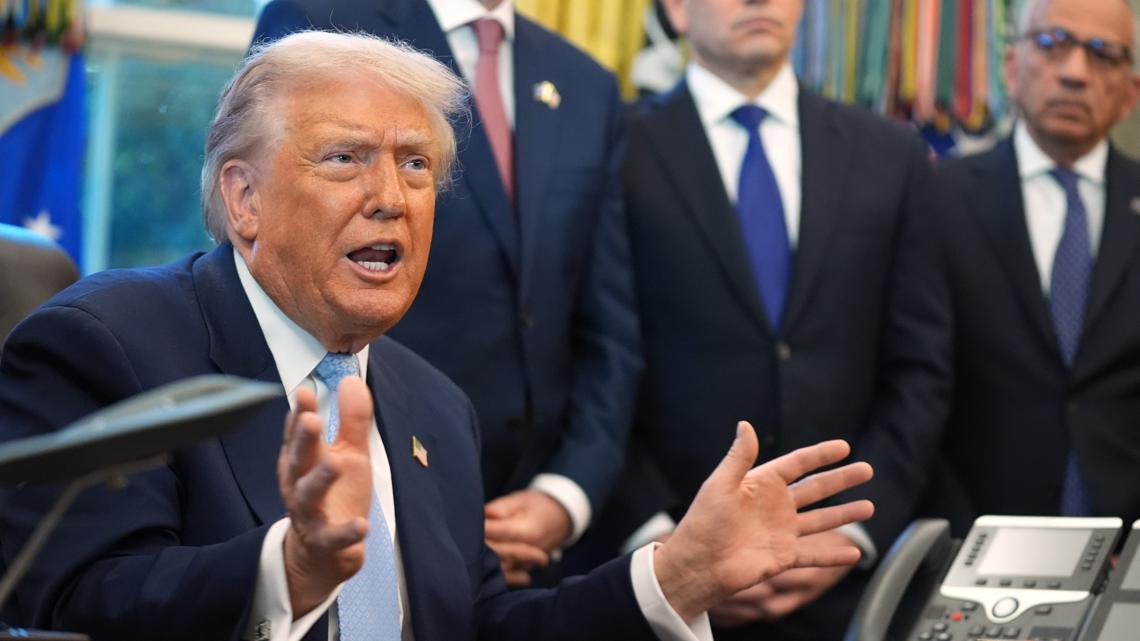Trump has repeatedly doubled down on the proposal, even setting a mid-2026 timeline. But can he do it without first getting congressional approval?
WASHINGTON — Several Trump administration officials have cautioned that the president’s proposal to send Americans rebate checks from tariff revenue requires congressional legislation.
As of now, the idea of Congress passing a bill to allow the $2,000 dividend checks seems like a long shot. Earlier this summer, Republican Sen. Josh Hawley introduced the American Worker Rebate Act for a stimulus check, but the idea fell flat among his colleagues in the Republican-controlled Congress. Several Republican senators shot down the tariff rebate check plan publicly, calling the proposal everything from “a bad idea” to “insane.” Most conservatives instead want to use any tariff revenue to pay down the massive national debt.
But is there a way to bypass Congress? The White House is certainly eyeing the possibilities.
During a Bloomberg event, Deputy White House Chief of Staff James Blair said that the White House will look “as hard as possible” to see if they can issue the $2,000 rebate checks without a green light from Congress. Blair, however, did express skepticism about the pathway.
“We will look as hard as possible to see if there’s a way to do it without Congress because we’re circumspect about Congress wanting to stop [them],” Blair said at a Bloomberg Government event Tuesday. “The law is the law. I think that the most likely outcome is that it requires an act of Congress.”
Following Blair’s remarks, House Speaker Mike Johnson said he thinks the plan needs Congressional approval.
“James Blair and I’ll have some intense fellowship about that…We collaborate on strategy all the time, but this is an idea I think that makes sense. The president was talking about as recently as yesterday,” Johnson said, according to Wall Street Journal reporter Olivia Beavers. “I’ll see him in a little while, but I think what I heard him say yesterday is he’s thinking about something maybe midway into next year, when the tariff revenue is realized and we can figure out what that looks like.“
On Monday, President Donald Trump said the proposed checks could arrive by mid-2026.
“We have thousands of dollars for individuals of moderate income, middle income. We are going to pay down debt,” he said to reporters. “We have a lot of money from tariffs; if we didn’t have tariffs, this country would be in serious trouble.”
Despite repeated talks about the plan, the future of the president’s tariff policy remains in the Supreme Court’s hands.
In a hearing earlier this month, the justices sounded skeptical about the Trump administration’s assertion of sweeping power to declare national emergencies to justify the tariffs. Trump has bypassed Congress, which has authority under the Constitution to levy taxes, including tariffs.
If the court strikes down the tariffs, the Trump administration may have to refund the tariffs to importers, making dividend checks to American families no longer even a possibility.
Treasury Secretary Scott Bessent said Sunday he doesn’t think the Supreme Court would rule against the tariff policy.
“I don’t think this ruling is going to go against us,” he said. “But if it does, what’s their plan for refunds? Because how is this going to get to consumers? Are they gonna hand some of these importers big windfalls?”
“I don’t think the Supreme Court wants to wade into a mess like that,” he added.
Blair also repeated the sentiment, saying that the odds are “50-50.” He also expressed that if the Supreme Court strikes down the policy, the president will reissue it through different means.
Who will get Trump’s $2,000 tariff rebate checks?
Much remains unclear about the dividend check proposal.
Several officials, including Trump, have said the checks will be for “working families” and for “moderate” and “middle” income families. Bessent also said the checks would have income limits.
Trump has boasted that “trillions of dollars” are coming into the U.S. from tariffs, but budget experts say the math doesn’t quite add up.
John Ricco, an analyst with the Budget Lab at Yale University, estimates that Trump’s tariffs will raise $200 billion to $300 billion in annual revenue. But a $2,000 dividend — if it went to all Americans, including children — would cost $600 billion.
“It’s clear that the revenue coming in would not be adequate,” he said.
As of Sept. 30, the federal government had generated $195 billion in tariff revenue.
This isn’t the first time Trump has pushed the idea of a payout for Americans due to his policies.
In February, the Republican president said he liked the idea of giving some of the savings from Elon Musk’s Department of Government Efficiency, or DOGE, back to Americans as a dividend.
At the time, Trump said his administration was considering a plan in which 20% of the savings from DOGE federal budget cuts would go to U.S. citizens, and the other 20% would help pay down the national debt. The plan never materialized, and months later, Musk left the DOGE office.
